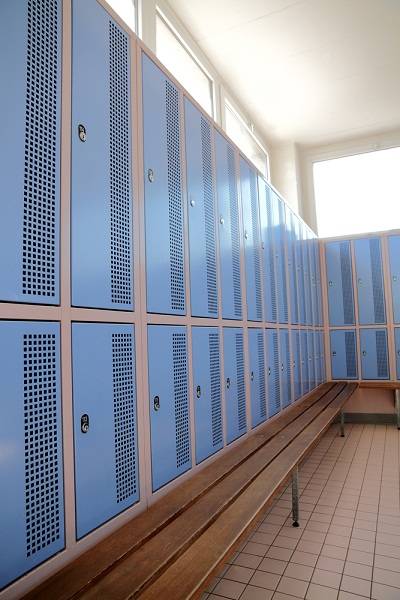Methicillin-resistant staphylococcus aureus (MRSA) infections are rampantly spreading in gyms, locker rooms, and athletic facilities. Staphylococcus aureus (staph) is a common bacterium that causes a wide range of illnesses, from mild skin infections to more serious systemic infections including, fatal bacteremia, necrotizing pneumonia, and necrotizing fasciitis. MRSA is a virulent staph infection that has a resistance to many different antibiotics which makes it extremely
difficult to treat.
The most common risk factors for developing a MRSA infection are poor personal hygiene practices, participation in contact sports, open skin wounds and abrasions, shaving, contaminated athletic equipment, contaminated athletic training rooms, and use of contaminated whirlpools or sauna.
Hygiene practices in a gym setting are often left up to the coaches and trainers to maintain daily. Recent research in the Journal of Athletic Training, examined basic MRSA knowledge regarding infection and prevention practices in a large sample of certified athletic trainers. Researchers analyzed 163 athletic trainers from National Collegiate Athletic Association Divisions I, II, and III and high schools, representing all 10 National Athletic Trainers’ Association districts.
Results:
- 92% of the athletic trainers indicated that MRSA was a problem, but only 57% perceived MRSA as a problem in their gym.
- 88% of trainers reported working with an athlete with a skin or limb infection, of these infections 75% were thought to be staphylococcal infection, and 57% were MRSA infections that were diagnosed by a physician.
- 50% of trainers reported American football as the most common sport of athletes treated for MRSA infections.
- 42% of trainers reported the most common locations for MRSA infections were the regions of the lower leg or feet.
- 42% of trainers stated the reason they chose to use certain cleaning products in their gym was conventional wisdom, not CDC recommendations for cleaning and disinfection.
- 35% of trainers indicated that they frequently washed their hands, while 32% admitted they only washed their hands sometimes.

- 32% of trainers used an alcohol based hand sanitizer only sometimes before/after working with an athlete, and only 29% used sanitizer frequently after each athlete.
- 30% of trainers failed to correctly identify cleaning solutions for appropriate hygiene and disinfection.
- 83% of trainers stated that they had manual dispensers for soap and alcohol-based hand sanitizer.
- 10% of trainers did not know that whirlpools could be a virulent source of MRSA infection.
- 14% of trainers stated that they cleaned whirlpools after each use (the CDC recommends all whirlpools must be clean after each user, no exceptions).
- 14% of trainers reported that they adhered to the CDC recommendations for appropriate disinfection.
Researchers suggest that most trainers sampled lacked crucial knowledge about MRSA and proper disinfection practices. Results indicated that athletic trainers must have a basic understanding the importance hand washing hygiene. Trainers should also receive more education based on CDC/EPA guidelines regarding dangerous hygiene issues and proper disinfection practices to implement in their facilities.
For Further Information Regarding Recommendations for MRSA Prevention in Athletic Facilities:






